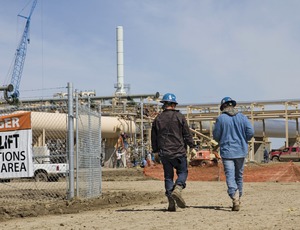Unions Push To Find and Train Workers in North Dakota Boom

Unions in North Dakota have launched what they say is an unprecedented push to recruit skilled construction workers to the booming oil-and-gas building sector there, despite the state's right-to-work status that bans requiring paid union membership to work.
The initiative, called Dakota Construction Careers, includes ironworkers, bricklayers, cement masons, operating engineers, laborers and painters.
The North Dakota Building Trades Council, Bismarck, says it has more than 100 signatory contractors. "A contractor's available manpower at the time of the bid will determine who gets the contract, not how low the bid," says council President Cory Bryson.
Job fairs are set in at least 12 cities. State unions see dramatic manpower needs for proposed projects such as a $450-million refinery in Makoti and two multibillion-dollar pipelines to transport crude oil from the Bakken shale region to Minnesota.
Jason Ehlert, a building trades official in Fargo, also notes about $1.5 billion in infrastructure work. "There are some highly technical skills needed on these projects," he says. "Contractors want workers who understand that."
Union officials say their numbers are growing. "Three years ago, we had about 110 members in the [state laborers'] union," Bryson says. "We finished 2013 with about 600 and anticipate 1,000 by the end of 2014."
Norman Voorhees, an ironworkers' union official in Duluth, Minn., says,"there's nothing about 'right to work' that says you can't join a union."
But limited training facilities and available instructors remain a challenge. "We have apprentices and workers who sometimes have to go to Fargo or to Minneapolis for safety training," says Ehlert.
"About 16,000 workers now are needed in North Dakota and not just in construction, so unions, like a lot of people, are scratching their heads to figure out how to fill these positions," says Bob Heise, Associated Builders and Contractors president in North Dakota and Minnesota. "But the statistics are strong: About 93% of North Dakota workers choose to work for open-shop contractors."
Nationally, shortages of in-demand construction skills helped drive down hiring rates in late 2013, despite a big increase in job openings, says a new analysis of Bureau of Labor Statistics' data by accounting firm Marcum LLP.
It notes a 4.6% hire rate in December 2013, the lowest since February 2007, although there were more job openings than in any month since August 2007.
Workers "are either unwilling or unable to accept available jobs," says Anirban Basu, Marcum chief construction economist. He says the skills shortage "will worsen over time, eventually translating into significant construction wage growth."
The firm's analysis also shows that employers are working harder to retain workers. Marcum says the December 2013 rate of job "separations," such as resignations and layoffs, was well below historic averages.



